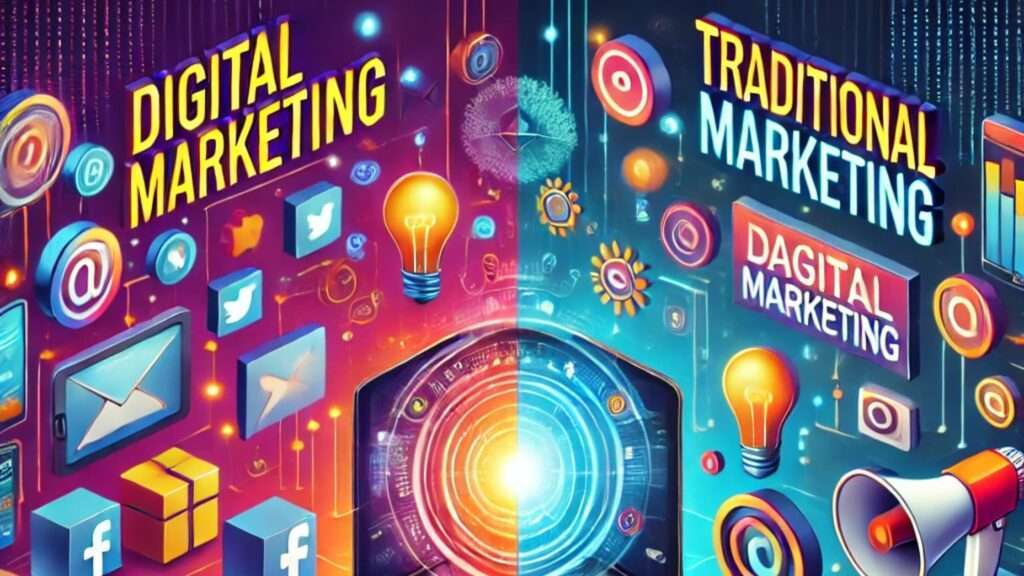
Digital Marketing and Traditional Marketing: Marketing is the cornerstone of any successful business strategy. With the evolution of technology, businesses now face a pivotal decision: whether to focus on digital marketing, traditional marketing, or a blend of both. In this post, we will explore the key differences, benefits, and drawbacks of digital marketing and traditional marketing to help you make an informed decision.
Digital Marketing and Traditional Marketing
What is Digital Marketing?
Digital marketing encompasses all marketing efforts that use electronic devices and the internet. Businesses leverage digital channels such as search engines, social media, email, and websites to connect with their audience. Popular forms of digital marketing include:
- Search Engine Optimization (SEO): Improving website visibility in search engine results.
- Social Media Marketing: Engaging audiences on platforms like Facebook, Instagram, LinkedIn, and Twitter.
- Content Marketing: Creating valuable content to attract and retain customers.
- Pay-Per-Click Advertising (PPC): Paid ads on platforms like Google Ads and social media.
- Email Marketing: Direct communication with prospects and customers through email campaigns.
What is Traditional Marketing?
Traditional marketing refers to conventional forms of marketing that do not involve the internet. These include:
- Print Advertising: Newspapers, magazines, and brochures.
- Broadcast Advertising: Television and radio commercials.
- Outdoor Advertising: Billboards, posters, and transit ads.
- Direct Mail: Flyers, catalogs, and postcards sent directly to potential customers.
- Telemarketing: Calling potential customers to promote products or services.
Key Difference Between Digital Marketing and Traditional Marketing
- Reach:
- Digital marketing allows businesses to reach a global audience instantly, while traditional marketing often targets a specific geographic region.
- Cost:
- Digital marketing campaigns are generally more cost-effective, especially for small businesses, compared to traditional methods like TV commercials or print ads.
- Measurability:
- Digital marketing provides real-time data and analytics, allowing businesses to track performance. Traditional marketing lacks such immediate feedback mechanisms.
- Engagement:
- Digital marketing fosters two-way communication through social media and interactive content, whereas traditional marketing is primarily one-way.
- Flexibility:
- Digital campaigns can be adjusted in real-time, while traditional marketing strategies are harder to modify once launched.
| Aspect | Digital Marketing | Traditional Marketing |
|---|---|---|
| Reach | Global audience with instant access | Targets specific geographic regions |
| Cost | Generally more cost-effective | Higher costs for TV, print, or outdoor ads |
| Measurability | Real-time analytics and performance tracking | Limited tracking and delayed feedback |
| Engagement | Two-way communication through social media and interactive content | One-way communication through static ads |
| Flexibility | Real-time adjustments to campaigns | Difficult to modify once launched |
Pros and Cons of Digital Marketing
Pros:
- Cost-effective and accessible for businesses of all sizes.
- Precise targeting and personalization.
- Real-time analytics and performance tracking.
- Broad reach and scalability.
Cons:
- Requires technical expertise and consistent updates.
- Saturated market leading to high competition.
- Privacy concerns with data collection.
Pros and Cons of Traditional Marketing
Pros:
- Tangible and memorable materials like brochures or billboards.
- Reaches audiences less active online.
- Builds credibility through established media channels.
Cons:
- Higher costs and limited measurability.
- Slower to reach target audiences.
- Difficulty in engaging with modern tech-savvy consumers.
Finding the Right Balance
The choice between digital marketing and traditional marketing depends on your business goals, target audience, and budget. Many successful businesses adopt an integrated approach, combining the broad reach of traditional marketing with the precise targeting capabilities of digital marketing.
For instance:
- A local restaurant might use billboard advertising to attract passing traffic while maintaining an active social media presence to engage with younger customers.
- A global e-commerce brand might focus on SEO and PPC campaigns to drive online sales while investing in print ads during holiday seasons.
Conclusion: Digital Marketing and Traditional Marketing
Digital marketing and traditional marketing each have their unique strengths and challenges. By understanding their differences and aligning them with your business objectives, you can create a comprehensive marketing strategy that maximizes your reach and impact. Embrace the strengths of both approaches to stay competitive in today’s dynamic market.
Related Articles
- Amazon Digital Media Marketing: A Comprehensive Guide for Brands
- Understanding Digital Paid Media: A Complete Guide
- Paid Search Marketing Is Entirely Driven by Google
- Paid Search Engine Optimization: Maximizing Your ROI
- Digital Marketing Optimization: Unlocking Success in the Digital Age
- SCO in Digital Marketing: Unlocking the Potential of Search Content Optimization
- The Power of Internet and Social Media Marketing: A Game-Changer for Businesses
- Digital Marketing Creative Ads: Capturing Attention in the Digital Age
- BBA in Digital Marketing in India: A Comprehensive Guide
- Diploma in Digital Marketing in India: A Comprehensive Guide
- MBA in Digital Marketing in India: A Complete Guide
- E commerce and Internet Marketing: A Perfect Symbiosis
- Digital and Content Marketing – The Ultimate Guide to Elevate Your Brand
- Retail Digital Marketing: A Complete Guide to Boost Your Sales
- Basic Social Media Marketing: A Beginner’s Guide
